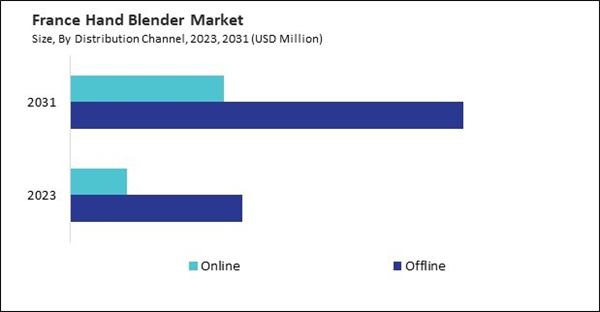Online distribution channels have become increasingly vital in the hand blender market, driven by the growing trend of e-commerce and changing consumer shopping habits. These channels allow manufacturers and retailers to reach a broader audience by selling hand blenders directly through their websites or third-party platforms like Amazon, eBay, and other online marketplaces. Online shopping offers consumers the convenience of browsing a wide range of products from the comfort of their homes, comparing prices, and reading customer reviews before making a purchase decision. Thus, the Germany market is expected to sale 1.95 million units of hand blender by online distribution channel by 2031.
The Germany market dominated the Europe Hand Blender Market by Country in 2023, and is expected to continue to be a dominant market till 2031; thereby, achieving a market value of $425.7 Million by 2031. The UK market is exhibiting a CAGR of 10.1% during 2024-2031. Additionally, the France market would experience a CAGR of 12.2% during 2024-2031.
As consumer preferences evolve, several trends are shaping the hand blender market. There is a growing demand for sustainable kitchen appliances. Manufacturers are increasingly focusing on eco-friendly materials and energy-efficient designs. Hand blenders made from recyclable materials are gaining traction among environmentally conscious consumers.
Additionally, the incorporation of smart technology is becoming more prevalent in kitchen appliances, including hand blenders. App connectivity, touch controls, and programmable settings enhance user experience and convenience.
As urban areas grow, there is a noticeable trend toward smaller living spaces, including apartments and compact kitchens. This environment drives consumers to seek multifunctional kitchen appliances that can save space while enhancing culinary capabilities. Hand blenders, known for their versatility and ease of use, are becoming essential tools in modern urban kitchens. The convenience they offer and their ability to prepare a variety of dishes quickly align perfectly with the fast-paced lifestyle of urban consumers.
List of Key Companies Profiled
- Robert Bosch GmbH (BSH Home Appliances Corporation)
- Koninklijke Philips N.V.
- Panasonic Holdings Corporation
- Whirlpool Corporation
- Wonderchef Home Appliances Pvt. Ltd.
- Breville Group Limited
- SMEG S.p.A.
- Hamilton Beach Brands, Inc. (Hamilton Beach Brands Holding Company)
- Cuisinart Corporation (Conair Corporation)
- Spectrum Brands Holdings, Inc.
Market Report Segmentation
By Product (Volume, Thousand Units, USD Billion, 2020-2024)
- Corded
- Cordless
By Application (Volume, Thousand Units, USD Billion, 2020-2024)
- Residential
- Commercial
By Distribution Channel (Volume, Thousand Units, USD Billion, 2020-2024)
- Offline
- Online
By Country (Volume, Thousand Units, USD Billion, 2020-2024)
- Germany
- UK
- France
- Russia
- Spain
- Italy
- Rest of Europe
Table of Contents
Companies Mentioned
- Robert Bosch GmbH (BSH Home Appliances Corporation)
- Koninklijke Philips N.V.
- Panasonic Holdings Corporation
- Whirlpool Corporation
- Wonderchef Home Appliances Pvt. Ltd.
- Breville Group Limited
- SMEG S.p.A.
- Hamilton Beach Brands, Inc. (Hamilton Beach Brands Holding Company)
- Cuisinart Corporation (Conair Corporation)
- Spectrum Brands Holdings, Inc.
Methodology

LOADING...









